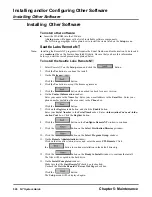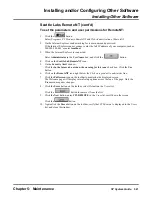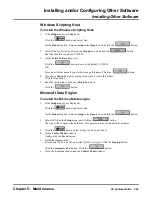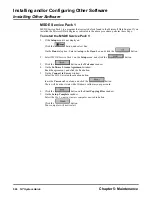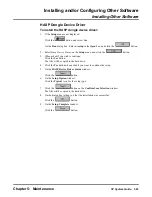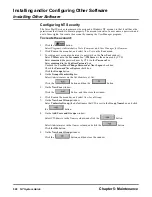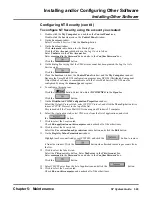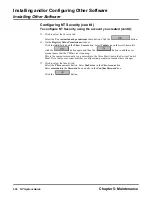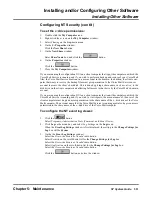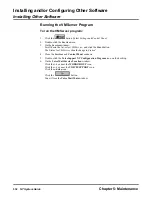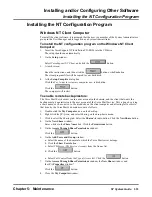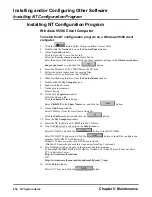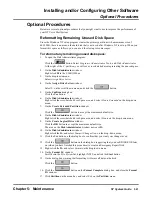
Installing and/or Configuring Other Software
Installing the NT Configuration Program
534
NT System Guide
Chapter 5: Maintenance
Windows NT Client Computer (cont’d)
To enable reports:
The account name of the user of the client computer must be given access permission to the share
name of the c: disk drive of the Voice Mail computer. This can be done for all clients by allowing
the predefined group VMServiceGroup in the predefined access domain to have access to the c:
drive. This group name and domain name must be set in the registry. The client account must be a
member of this group.
1.
On the Server computer:
Double-click the My Computer icon on the desktop.
2.
Right-click the [C:] icon on the My Computer window.
3.
Select Sharing on the drop-down menu.
4.
On the (C:) Properties window:
Select the Shared As radio button. Click the New Share button.
5.
On the New Share window:
Enter c-drive in the Share Name box. Click the Permissions button.
6.
On the Access Through Share Permissions window:
Click the
button.
7.
On the Add Users and Groups window:
Select VMServiceGroup on the scroll-down Names list. Select the name of the domain to
which the Voice Mail Server belongs from the List Names From list.
Click the
button.
Select Full Control from the Type of Access list. Click the
button.
8.
On the Access Through Share Permissions window, the New Share window, and the (C:)
Properties :
Click the
button.
9.
Close the My Computer window.
To allow multiple users to access Voice Mail database at same time:
To protect the integrity of the Voice Mail data, only one user at a time can normally make changes
to the database. However, to override this protection, do the following from the Client Computer:
1.
Click the Start button. Select Run.
2.
Click the
button on the Run window.
3.
On the Browse window:
Double-click the Program Files folder. Double click the CTLInc folder. Double click the
VoiceSupport NT Configuration Program folder. Select All Files (*.*) from the Files of type
list. Double click the VMDBUnlock icon.
4.
Click the
button on the Run window.
5.
Click the
button on the Registry Editor dialog box.
6.
If you are running the Windows NT GUI:
Click File on the menu bar and select Close on the File menu.
But if you are not running the Windows NT GUI:
Double-click the VoiceSupport NT Configuration Program icon on the desktop.
Now you can use the options on the Customize menu to make changes to the Voice Mail
database from the Client Computer.
Summary of Contents for NVM-NT
Page 28: ...Table of Contents Chapter 5 Maintenance xxvi NT System Guide ...
Page 130: ...Installing SMDI 102 NT System Guide Chapter 3 Programming ...
Page 146: ...Customizing Caller I D Tables General Tab 118 NT System Guide Chapter 3 Programming ...
Page 156: ...Customizing Callout Options Optional Tab 128 NT System Guide Chapter 3 Programming ...
Page 182: ...Customizing Distribution Lists General Tab 154 NT System Guide Chapter 3 Programming ...
Page 338: ...Customizing Port Options General Tab 310 NT System Guide Chapter 3 Programming ...
Page 358: ...Customizing System Options Timers Tab 330 NT System Guide Chapter 3 Programming ...
Page 362: ...Customizing System Options Timers Tab 334 NT System Guide Chapter 3 Programming ...
Page 367: ...Customizing Tenant Options General Tab Chapter 3 Programming NT System Guide 339 ...
Page 396: ...Viewing and Printing Reports System Options Report 368 NT System Guide Chapter 3 Programming ...
Page 400: ...Performing a Local Backup Backup Dialog Box 372 NT System Guide Chapter 3 Programming ...
Page 440: ...Using Port Activities 412 NT System Guide Chapter 3 Programming ...
Page 454: ...Using Message Status Message Status Dialog Box 426 NT System Guide Chapter 3 Programming ...

